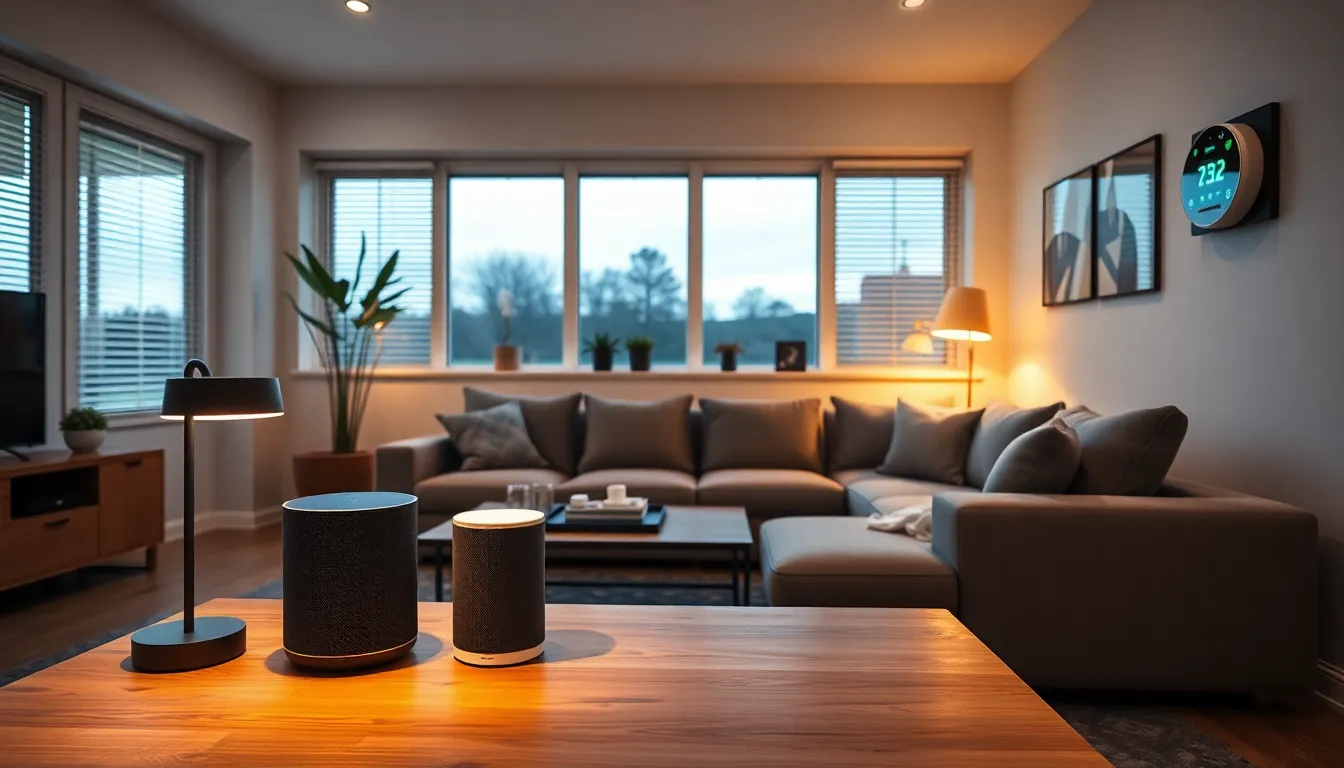In today’s fast-paced world, digital home technology is transforming the way people live, work, and interact with their surroundings. From smart speakers that respond to voice commands to energy-efficient appliances that learn user preferences, these innovations are making homes more convenient and efficient. As technology continues to evolve, homeowners are embracing these advancements to enhance their quality of life.
The integration of digital tools into everyday living not only simplifies tasks but also offers unprecedented control over home environments. With the rise of the Internet of Things (IoT), devices seamlessly connect and communicate, allowing for a truly smart home experience. This article explores the latest trends and essential gadgets that are reshaping modern homes, making them smarter, safer, and more enjoyable.
Table of Contents
ToggleOverview of Digital Home Technology
Digital home technology encompasses a wide range of devices and systems that enhance the functionality and efficiency of residential spaces. Innovations such as smart speakers, smart thermostats, and home security systems contribute to seamless home automation. These technologies enable users to control various aspects of their homes remotely through smartphones or voice-activated commands.
The Internet of Things (IoT) plays a crucial role in this domain by connecting devices and allowing for real-time communication between them. IoT integration streamlines tasks like managing energy consumption, accessing security feeds, and monitoring home conditions. Smart appliances, such as refrigerators and washing machines, adapt to user preferences, optimizing performance and convenience.
Recent advancements in digital home technology include voice recognition software and AI-driven personal assistants. These features enhance user interaction, making technology more accessible. Additionally, energy management systems leverage data analytics to reduce electricity consumption, promoting sustainability and cost savings.
Table 1 outlines key categories of digital home technology, highlighting examples and benefits.
| Category | Examples | Benefits |
|---|---|---|
| Smart Speakers | Amazon Echo, Google Nest | Hands-free control, entertainment |
| Smart Thermostats | Nest, Ecobee | Energy savings, comfort adjustments |
| Home Security Systems | Ring, Arlo | Enhanced safety, remote monitoring |
| Smart Appliances | Smart fridges, robotic vacuums | Efficiency, ease of use |
| Home Automation Hubs | Samsung SmartThings, Apple HomeKit | Centralized control, interoperability |
Overall, digital home technology significantly transforms how individuals interact with their living environments, making homes smarter and more attentive to user needs.
Key Components of Digital Home Technology

Digital home technology consists of various devices and systems that enhance the functionality of residential spaces. Key components include smart devices and home automation systems.
Smart Devices
Smart devices represent a crucial aspect of digital home technology. These gadgets enhance convenience and efficiency, allowing users to control home functions remotely. Examples include:
- Smart speakers: Enable voice-controlled music playback, weather updates, and smart home integration.
- Smart thermostats: Optimize energy usage by learning user preferences and adjusting temperatures accordingly.
- Smart lights: Offer customizable settings and the ability to schedule or automate lighting based on time or activities.
Smart devices utilize Wi-Fi or Bluetooth connectivity, enabling seamless communication with other devices. Their interconnectivity fosters an integrated home experience, enhancing ease of use and customization.
Home Automation Systems
Home automation systems serve as the backbone of digital home technology. These systems allow users to manage various features of their homes from a unified platform. Key elements include:
- Central hubs: Facilitate communication between different smart devices and provide a single point of control.
- Home security systems: Incorporate cameras, sensors, and alarms to ensure safety and monitor property activity, accessible via mobile devices.
- Energy management systems: Monitor usage patterns, providing insights to enhance energy efficiency and reduce utility costs.
Home automation systems enable users to create routines and triggers for their devices. For example, users can set smart thermostats to adjust temperatures automatically when they leave for work. This level of integration improves comfort and security in modern homes.
Benefits of Digital Home Technology
Digital home technology enhances everyday living through smart innovations that improve convenience, efficiency, and security.
Convenience and Efficiency
Digital home technology simplifies daily tasks by enabling remote control and automation of household devices. Users can manage appliances, lighting, and climate settings from their smartphones or through voice commands. For instance, smart thermostats can adjust temperature settings based on user preferences or occupancy, optimizing energy use. Additionally, smart speakers allow for hands-free operation of devices, contributing to a seamless user experience. This integration of devices streamlines household management, ensuring that essential functions operate efficiently while providing comfort.
Enhanced Security
Digital home technology significantly boosts security measures within residential settings. Smart security systems, including cameras, motion detectors, and alarms, offer real-time monitoring and alerts, enhancing peace of mind. Homeowners can view live feeds or receive notifications on their devices if unusual activities are detected. Furthermore, smart door locks enable keyless entry, allowing for secure access control. This level of connectivity ensures immediate responses to potential threats, creating a safer living environment and reducing the likelihood of security breaches.
Challenges and Considerations
Digital home technology presents several challenges that require attention, particularly regarding privacy and compatibility. Users must navigate these issues to fully benefit from advancements while ensuring their home’s security and functionality.
Privacy Concerns
Privacy concerns arise from the data collection practices of smart devices. Devices often gather personal information to enhance user experience, but this can lead to unauthorized access to sensitive data. For example, smart speakers may record conversations unintentionally, raising the risk of data breaches. Users must ensure devices are equipped with robust security features, such as end-to-end encryption, to protect their information. Employing strong password practices and regularly updating device software also reduces vulnerability to cyber threats.
Compatibility Issues
Compatibility issues frequently hinder the full integration of digital home technology. Different devices may not communicate effectively if they use varying protocols or platforms. For instance, a smart thermostat might work seamlessly with certain smart speakers but not with others. It’s crucial for users to research compatible devices and choose those that adhere to widely supported standards, such as Zigbee or Z-Wave. Ensuring that all components work together simplifies user experience and enhances overall home automation functionality.
Future Trends in Digital Home Technology
Digital home technology continues to evolve, signaling significant trends that shape future innovation. Expectations include advancements in artificial intelligence (AI) integration, improved interoperability, and enhanced user interfaces.
- AI-Enhanced Devices: AI-driven systems will provide smarter automation. Devices will learn user habits and preferences, personalizing experiences. For example, smart thermostats will automatically adjust temperatures based on historical usage patterns.
- Increased Interoperability: Future devices will focus on compatibility across brands. Seamless integration will allow varied devices, regardless of manufacturer, to communicate effectively. Users will benefit from enhanced functionality without the frustration of mixed systems.
- Voice-Control Expansion: Voice recognition technology will become more sophisticated. Users will experience greater accuracy and responsiveness, making voice commands the primary mode of interaction. Expanded language support will cater to a more diverse user base.
- 5G Connectivity: The rollout of 5G networks will enable faster and more reliable connections. High-speed internet will enhance the performance of smart devices, reducing latency and improving real-time decision-making capabilities.
- Advanced Security Features: Security measures will evolve to protect user data more effectively. Biometric authentication methods, such as facial recognition and fingerprint scanners, will become standard in smart locks and cameras, increasing home safety.
- Sustainability Initiatives: Eco-friendly devices will gain popularity, focusing on energy efficiency. Smart systems will provide insights on energy consumption and suggest optimization strategies, contributing to sustainable living practices.
- Health Monitoring: Home technology will integrate health monitoring features. Devices will track air quality, detect allergens, and even monitor vital signs, promoting wellness and preventive care in domestic settings.
- Augmented Reality (AR) Integration: AR will enhance the way users interact with their home technology. Virtual interfaces will allow users to visualize home design changes, monitor security feeds, or even control appliances using augmented overlays.
- Home Automation and Robotics: Robotics will play a significant role in future homes. Automated systems, from vacuum cleaners to lawn mowers, will operate more intelligently and autonomously, further reducing manual household tasks.
- Smart Energy Solutions: Energy management systems will become more advanced, utilizing real-time data to optimize resource use. These solutions will help users reduce waste and lower utility costs, aligning with global sustainability goals.
These trends indicate a future where digital home technology not only enhances convenience but also contributes significantly to security, efficiency, and sustainability.
Digital home technology is reshaping the way people live and interact with their environments. As innovations continue to emerge the potential for smarter homes grows exponentially. Enhanced convenience security and efficiency are just the beginning of what these advancements can offer.
With the integration of IoT and AI users can expect a more personalized and responsive home experience. The future holds exciting possibilities from improved energy management to advanced security features. Embracing these technologies not only enhances daily living but also paves the way for a more sustainable and connected lifestyle. As digital home technology evolves it promises to redefine modern living in ways that were once unimaginable.








